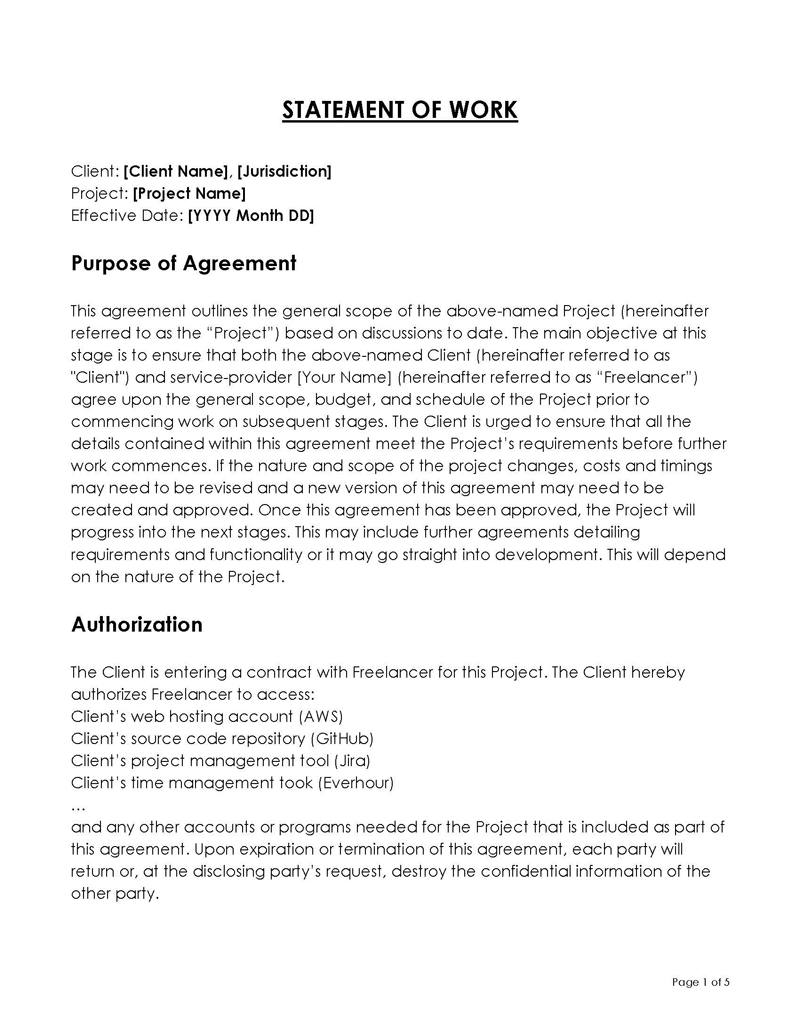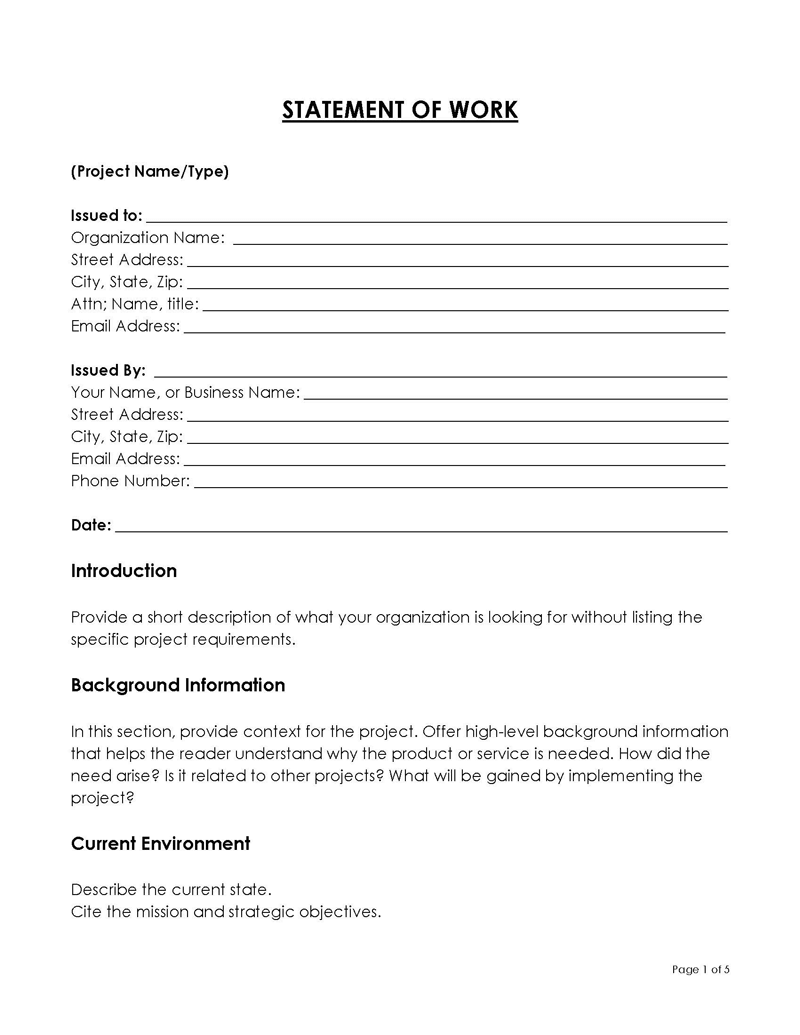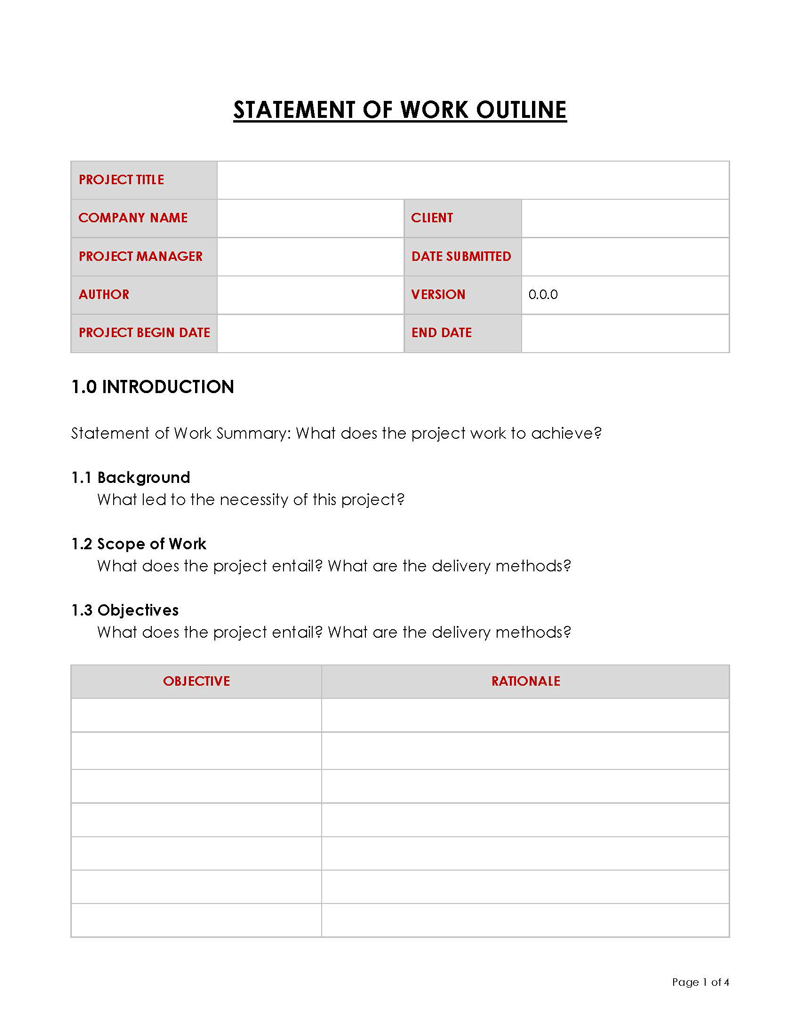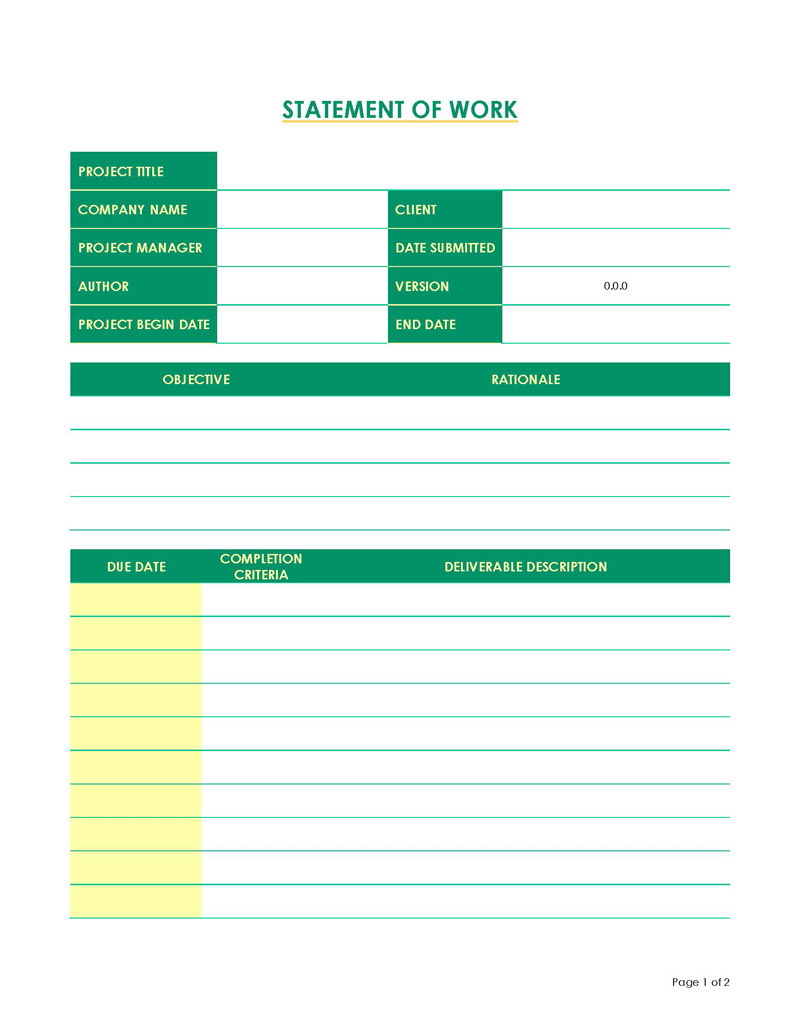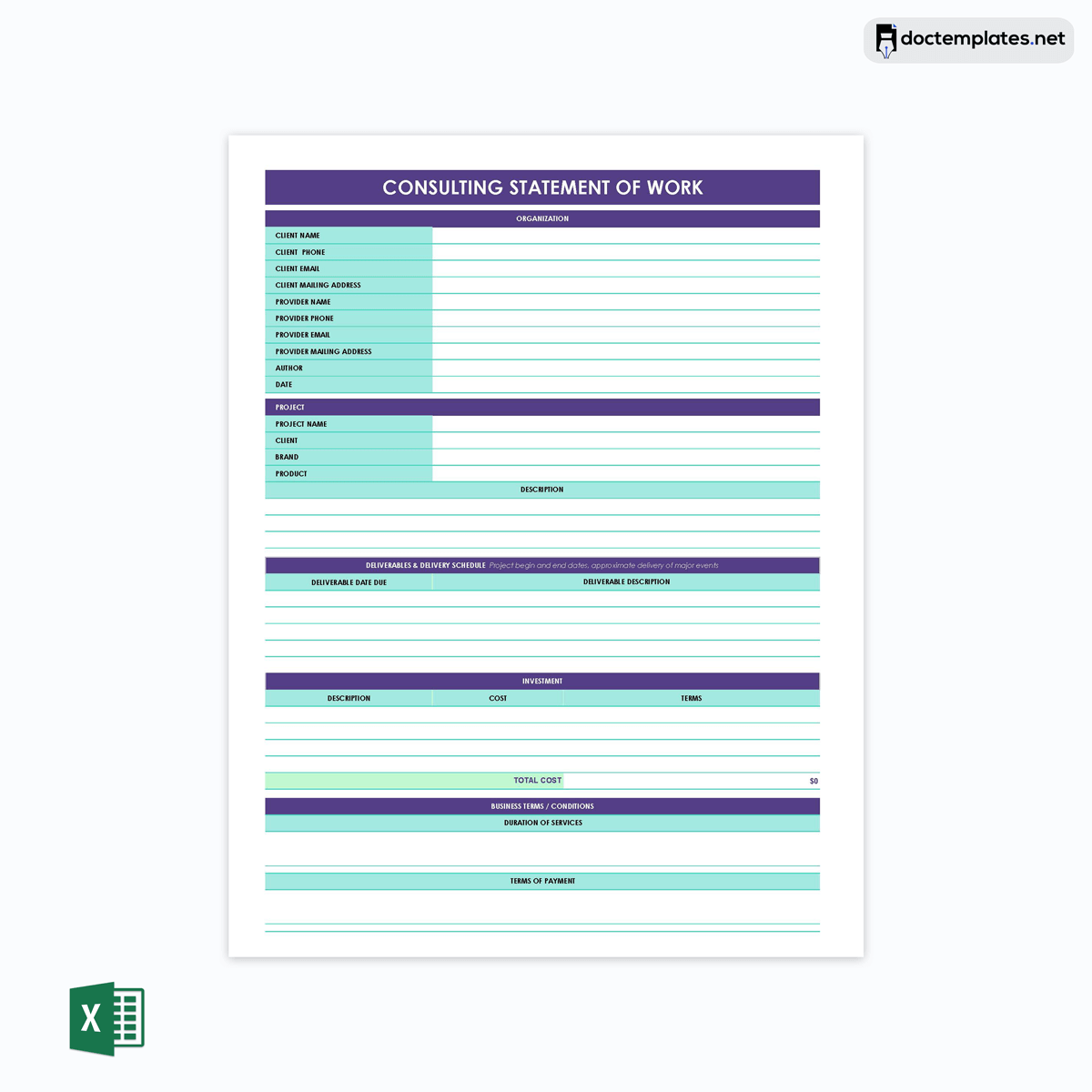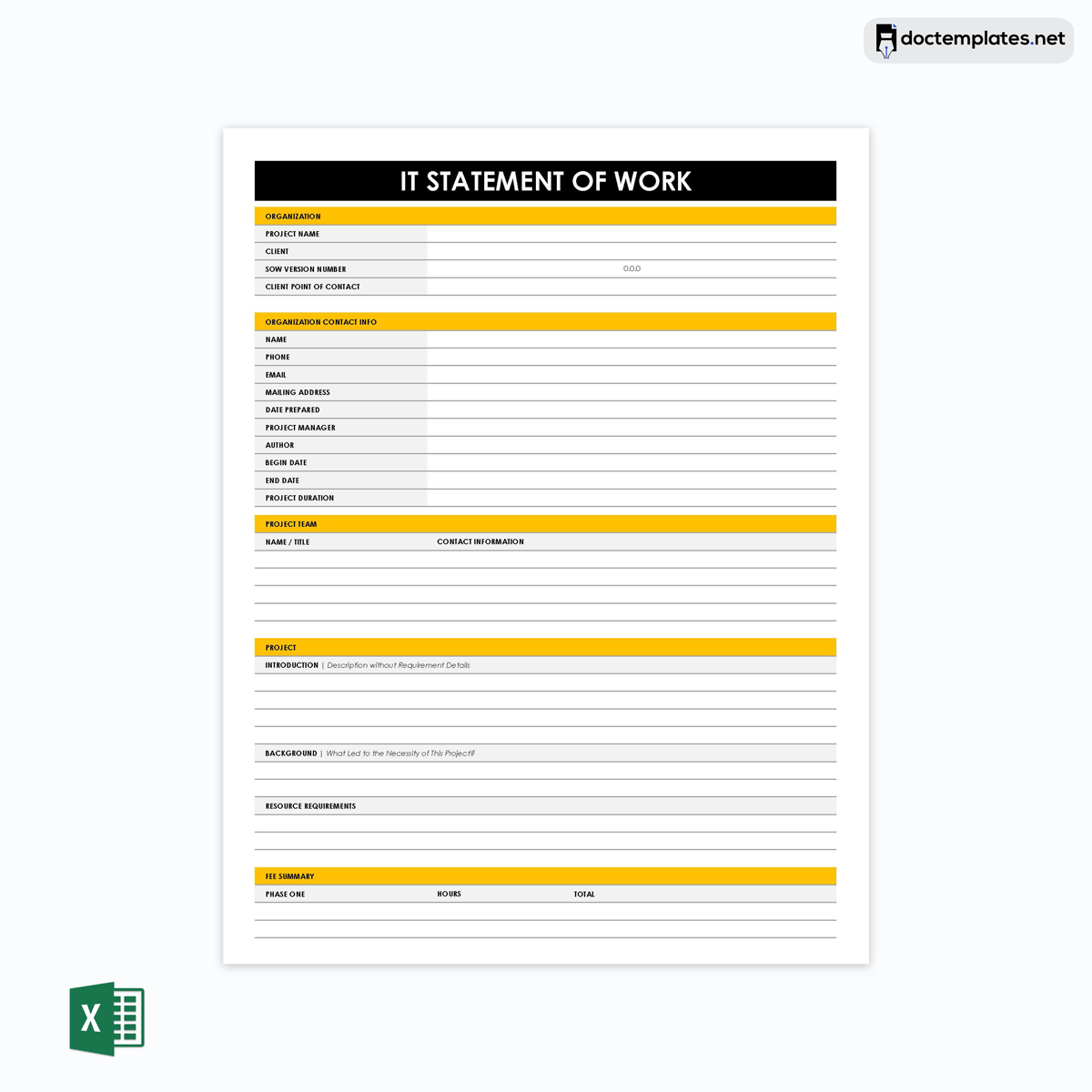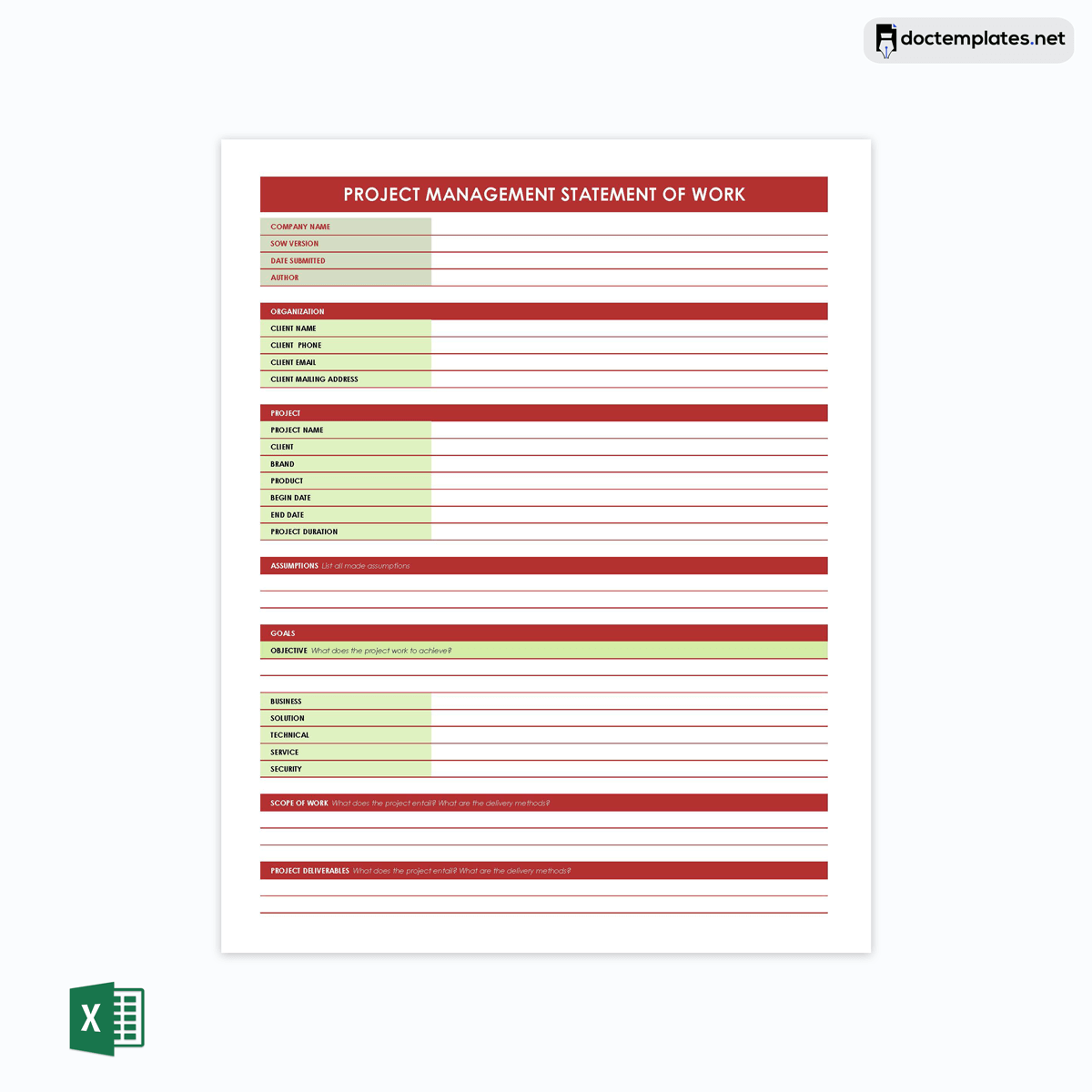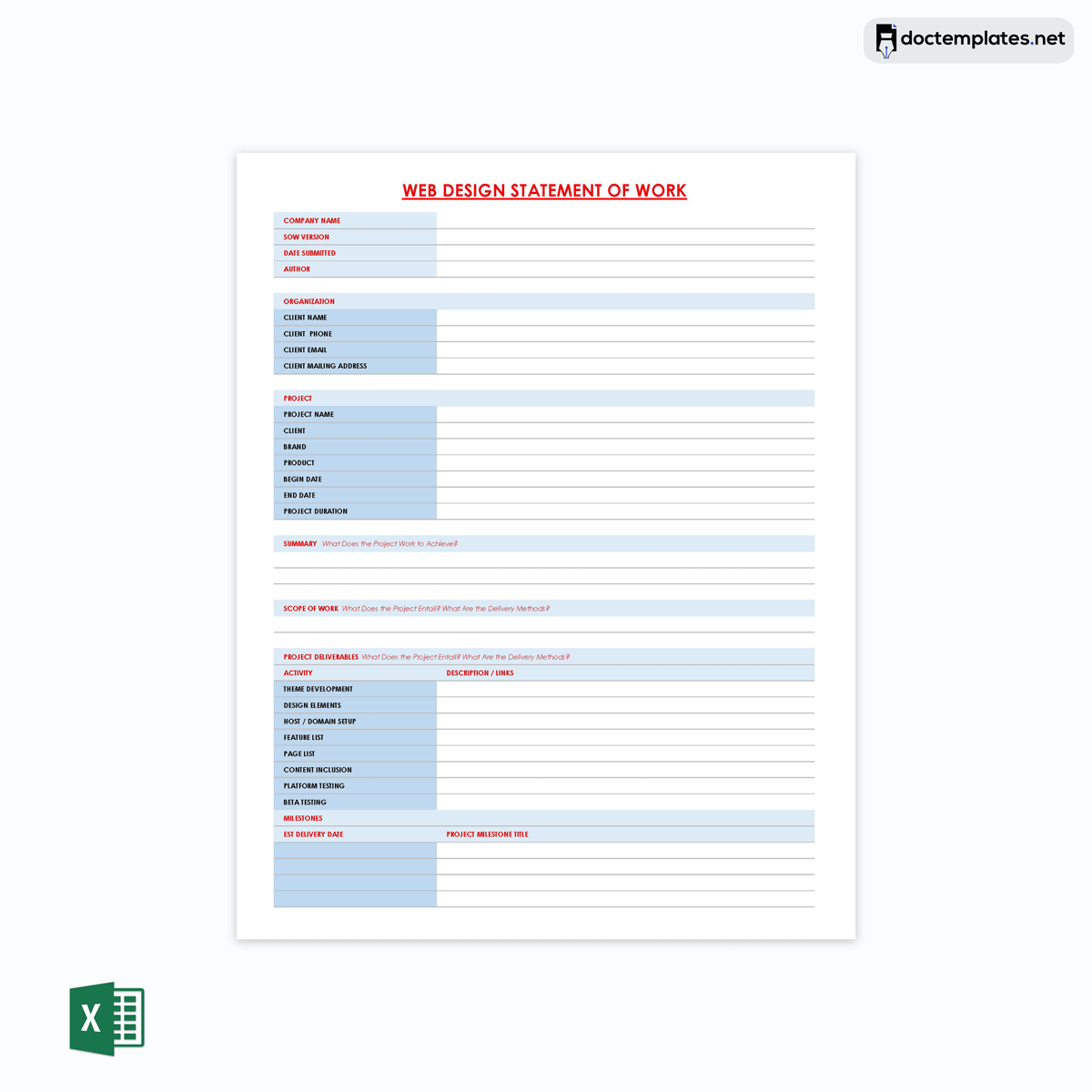If you are participating in a project that includes project-specific activities, deliverables, and timelines, you may need to sign the statement of work document. However, encountering this type of document for the first time can be intimidating, especially if you do not know what to expect.
A statement of work (SOW) is part of a legally binding contract that describes the requirements for working on a particular project.
Since it outlines the design and performance expectations, the SOW document should be written using precise language and accurate information. As a result, there are no misinterpretations or unclear clauses concerning the project’s terms and conditions.
This guide provides you with all the relevant information you may need. So whether you are interested in finding out more about the statement of work documents or you need some assistance in creating a draft, here you will find everything you want to know.
Statement of Work Template
Crafting a statement of work from scratch certainly takes a lot of time and effort. However, simply collecting important information can take several hours alone without sorting the gathered details and using them to describe different sections of the SOW document carefully.
Whether you do not have experience or time writing the statement of work documents or would like to receive a well-written SOW in a set time, you are in the right place.
Our statement of work template allows you to create a customized SOW in just a few minutes. Furthermore, you only have to download the statement of work template and complete the relevant information, as it is customizable and free.
What is a Statement of Work?
The statement of work (SOW) is a document that describes all the work management aspects relating to your project.
You can find all the relevant information about the project in this legally binding document. Furthermore, it includes the agreed-upon terms and conditions used as the project’s groundwork for the involved parties.
With that in mind, the statement of work is one of the initial documents created before planning and executing the project. Since the primary purpose of the SOW is to clarify the responsibilities, liabilities, and work agreements between parties involved, the document represents the project’s landscape that everyone can follow.
The SOW document is a standard part of another important document, a request for proposal (RFP), which solicits deals from vendors and different service providers.
The essential benefits of writing a statement of work include:
- Better project performance management
- Optimized workforce management
- Enhanced process efficiency
- Improved cost saving
- Detailed reports
- Mitigation of risks and supplier performance
- Greater visibility of outsourced projects
What is a Statement of Work Not?
As we briefly explained what constitutes the statement of work, it is essential to compare the SOW document to other similar documents to know the difference.
Request for proposal
A request for proposal (RFP) is used to outline what bidding parties are required to do relating to the completion of the project. Therefore, the primary purpose of an RFP is to find contractors and vendors who can provide the requested products and services. In addition, an SOW can contain a more in-depth description of the project in question.
Project charter
A project charter offers a brief overview of the project. It contains vital information about the project goals and objectives, stakeholders, project scope, and other crucial details. Therefore, a project charter can be helpful when writing an SOW.
Work breakdown structure
A work breakdown structure is a tool used by managers to break a larger and more complex project into individual phases and tasks. Since smaller milestones are easier to manage, doing so can help streamline the project’s progress.
Master service agreement
A master service agreement outlines the terms and conditions of parties during their partnership. Since the statement of work document only covers details for a particular project, a master service agreement is a perfect choice for defining the partnership details that exceed a single project.
Service procurement
A service procurement program is a process that deals with the services and deliverables you can find in a statement of work. While the SOW is a governing document for these services, the service procurement focuses on managing the expenses within this category. Therefore, there are usually multiple SOWs within a more extensive services procurement program.
Contract
Even though the SOW is a valuable document, it does not have all the elements of a contract. For example, the statement of work is negotiable and flexible to change, while the parties cannot easily change the details in the contract. Therefore, signing a contract is the final step that binds the involved parties together.
Scope of work
Scope of work is only a single element used in the statement of work document. This element describes tasks and milestones within a project. In contrast, the SOW includes other aspects besides the scope of work – mission, success criteria, deliverables, and preventing the project from developing outside the original scope of work.
When, Why and Who Can Use SOW?
Suppose you need a statement of work for your upcoming project. If you have not written one before, you are undoubtedly interested in learning more about when, why, and who can use an SOW.
When
When is the perfect time to start crafting a statement of work? Project managers should have the SOW in mind for the best results when preparing the elevator pitch and researching the client’s needs. During this stage, project participants can use the gathered information to draft an outline of the SOW document.
To elaborate these ideas into a well-written document, project managers need to answer a set of questions from their client’s perspectives, such as:
- How does the project work in favor of the addressed issue?
- Is it worth investing in the project?
- Is the offer unique?
Why
In this age when business professionals must prepare many documents and contracts, project managers are curious whether a statement of work is genuinely necessary. Why is the SOW so important?
Essentially, an SOW helps teams define the project requirements and expectations, so the chances of any misunderstandings during the project’s execution are minimized. In addition, although the involved parties might not be in direct contact, they are involved in the same project.
Having a clearly defined SOW from the beginning has many advantages, as discussed below:
States clear deliverables
With the statement of work, project managers are provided with a structure that states clear deliverables expected to occur with the project realization. When all parties understand the deliverables they are responsible for; it is much easier to avoid conflict and ensure everyone is agreed with the project.
Refines the project
The SOW does much more than act as a document that seals the agreement. Namely, a statement of work refines all the project details and invites parties to discuss different project scopes, such as the essential responsibilities, objectives, scopes of work, and goals.
Sets realistic expectations
Businesses and their clients can be quickly out of the project’s scope, especially if it is too time-consuming, complex, or expensive. As a result, they forget about their tasks and miss important deadlines. In most cases, that results in setting unrealistic expectations for both parties.
To avoid that, parties can use the SOW to set realistic expectations and base their daily decisions on this document. For example, they can distribute the tasks evenly and determine deadlines for every project activity or phase.
This way, the SOW documents cover much more than the fundamental project plans and costs. Instead, they include everything that will and will not be accomplished upon the project’s completion.
Clarifies in scope vs. out of scope
The role of a statement of work is to clarify the line between in-scope and out-of-scope ideas. On one hand, service providers can reduce the risk of scope creep. On the other hand, clients can better understand what they will receive and at what price.
Who
The person responsible for writing the SOW depends on whether your company is given an internal or external project. If you are working on an internal project, the project management office handles the paperwork, including a statement of work. That includes project stakeholders and user groups. However, if you are working on an external project, project managers, sponsors, clients, and even third parties can all have the task of writing the SOW document.
Nevertheless, it is essential to mention that statements of work are usually written when working on external projects, with project managers completing the required administrative tasks.
Types of the Statement of Work
Not all statements of work are the same. Here is how various SOW types are different:
Design/detail
The primary purpose of this type of SOW document is to clarify details about the project’s features and how the parties need to conduct work. This way, you are informing other project participants about the project requirements. In the design/detail SOW, buyers are usually responsible for the project’s progress and performance.
Level of effort/time and materials/unit rate
This type of statement of work is primarily for services. This SOW covers all the essential information regarding the work hours and the materials necessary for the performance of particular services for the duration of this legally-binding document. Essentially, this SOW type defines the level of effort, the materials, and the cost per unit.
Performance-based
A performance-based SOW focuses on providing more information about the project’s purpose. It also covers deliverables that are going to be accomplished and resources that are going to be provided. Since performance-based SOWs do not explain how work needs to be done, it is the perfect SOW type for companies seeking more flexibility and autonomy.
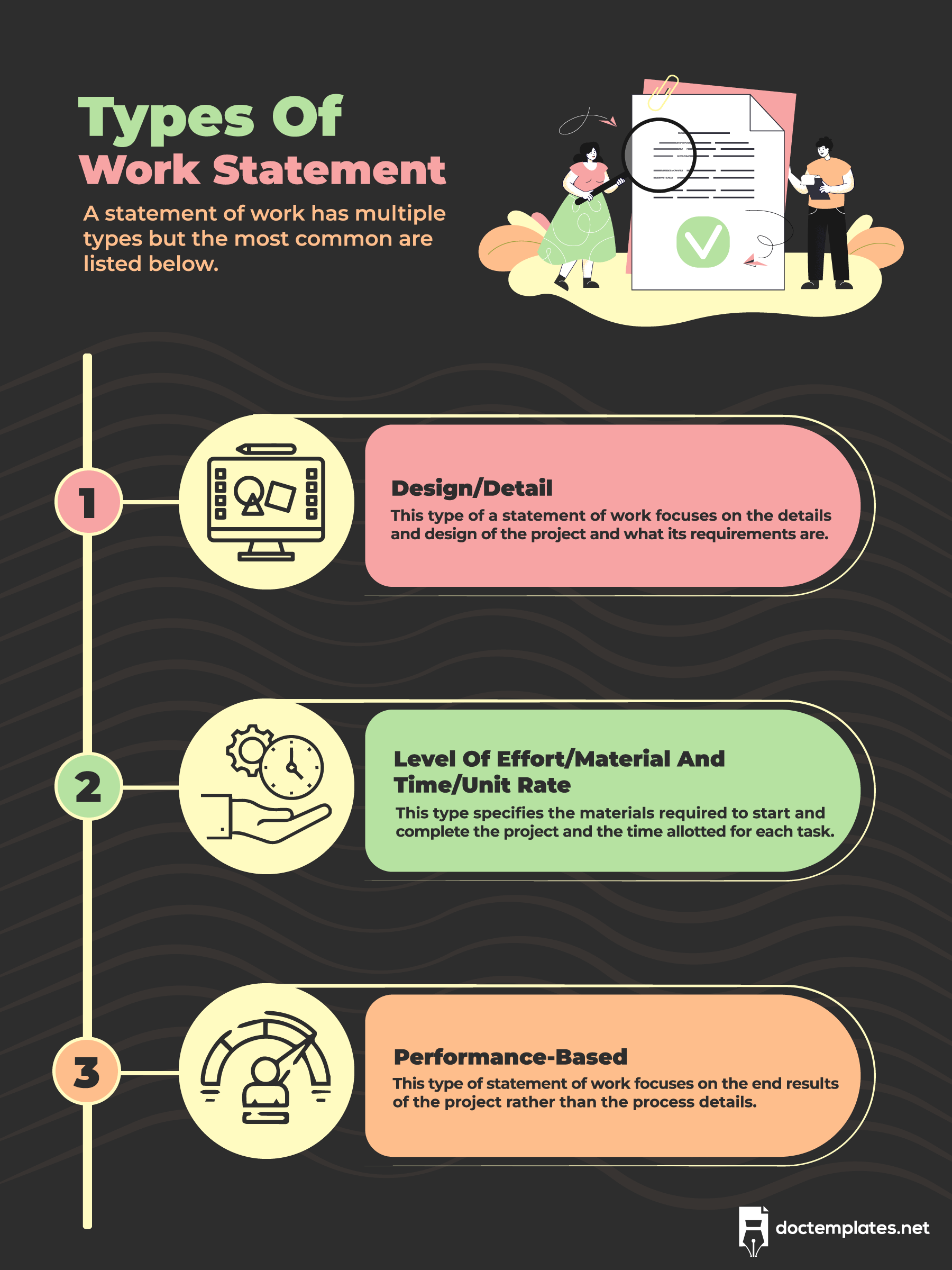
Elements of a Statement of Work
Now that you know what a statement of work represents, it is time to cover some essential elements every SOW should have:
Introduction of the project
Every vital document starts with a brief but informative introduction that covers general information about the project. SOWs are not an exception. From listing all project participants to explaining the critical goals and missions of the project, readers can find all the crucial information in the introductory part of a statement of work.
Purpose statement
The role of the purpose statement is to explain the reason behind initiating the project and the project’s primary goal. Even though the purpose statement is only a tiny part of the statement of work document, it covers critical details, including investments, deliverables, and return on investment.
Scope of work
The scope of work section deals with the work necessary for the project completion. It covers information about any hardware and software needs, as well as the process throughout the project, including:
- General steps to achieve the outcomes
- The necessary time to reach them
- Outcomes
Location (where the work will be done)
The parties must specify the project’s location since the entire team must work somewhere. Today, participants usually have two options: select a specific site where they will do all their work or work remotely. Whatever the case, providing a detailed description of the main activities’ location is crucial.
Tasks
The project’s introduction, purpose statement, and scope of work contain only general information about the necessary project tasks. This section is where project participants can say more about what they plan to do.
Therefore, use the project’s scope of work and break it into separate tasks. If that is not enough, you can also set phases and milestones for each task.
Milestones
Milestones measure the progress of longer and more complex projects. Defining the time necessary to complete every task makes it significantly more straightforward for all project participants to track and monitor the project’s performance. That is what milestones are for since you can use them to propose start and finish dates.
Deliverables
It is necessary to mention all deliverables of the project and list when each deliverable is due. Most project managers decide to include specific details, such as quantity, size, and color.
Schedule
A schedule is one of the most critical elements of the statement of work because it represents a timetable of all the project’s tasks, milestones, and resources throughout its lifecycle. Every project needs to contain a schedule that follows all the activities, but the parties can exclude it if the services delivered are continuous or in process.
Standard and testing
If your project must adhere to industry standards, mention them here.
Additionally, you should include details about the product testing if that is the case for your project. Consider mentioning:
- People or organizations participating in the testing process
- Equipment necessary for testing
- Other resources
Project success
Every statement of work should have a section describing how the project’s successful completion looks. Furthermore, project managers should include a list of all the project sponsors and stakeholders’ expectations once the project has been delivered.
Project requirements
If your project contains any other special terms, conditions, or requirements that do not fit into any of the categories above, this part is where you should cover them.
Payment terms
The budget is an integral part of every project, so specifying the payment terms is vital to ensure the parties’ consent regarding the delivery of payments. Whether you expect the payment before, during, or after the project completion, you should explain the details in the section covering payment terms. For example, payments could be made on a fixed schedule or after a task is completed.
Other
The project you are working on could have some other essential features that do not belong in any of the categories above. In that case, this section allows you to include everything else you might find crucial.
For instance, you could add details about:
- Security issues
- Hardware and software restrictions
- Client’s support after the project’s completion
Closure
Finally, the closing section deals with how the deliverables are accepted and who will review, deliver, and sign them. The closure also covers the final admin duties and ensures everything relating to the project is signed, closed, and archived.
Effective Practices
Are you looking for additional tips to help create a better statement of work?
The following are the most effective practices to ensure you end with a high-quality document:
Use understandable language
Using simple and understandable language is always recommended when crafting a statement of work. In addition, keeping the target audience in mind is essential, even if your SOW is industry-specific.
Generally speaking, not all parties work in the same industry, so it is vital to omit complex and jargon-filled language.
Here are some helpful tips:
- Use short and simple sentences
- Avoid industry-specific language
- Use noun-verb combinations
- Stick to the consistent use of words throughout the SOW
- Give the whole meaning of acronyms the first time you use them
- Create a glossary that will explain all the terms and acronyms you use in the SOW
- Include visuals, such as graphs, charts, and tables
- Provide enough details to explain unclarities, but not too many to cause bottlenecks
Be specific
Although you may think being specific is easy when writing a statement of work, you will quickly find it much more challenging than it may seem. Whether you are describing the expected quality of work or the process of measuring the success of milestones, it is pretty tricky to stay on track.
Being specific can be challenging for many reasons, mainly because:
- SOWs deal with complex types of work and contract mechanisms
- They are prone to high risks due to their legal, contractual, financial, organizational, and reputational features
- Qualified writers who are aware of the document’s contractual, operational, and financial obligations must write them
- They require a lot of time and effort to be written but must be submitted on short notice
Key Takeaways
Writing a statement of work from scratch requires time and effort, especially if you have never done it before. Fortunately, a handy checklist below can ensure you cover all the essential details and draft a well-written document.
During your SOW writing process, make sure to:
- Introduce the project and its participants
- Define the primary goal of the project
- Describe the project requirements
- Set the project’s scope of work
- Create deadlines for all deliverables
- Allocate the primary resources
- Manage the scope and the start and end dates of the project
- Define due dates and terms of payment
- List special requirements
- Accept and sign the SOW document
